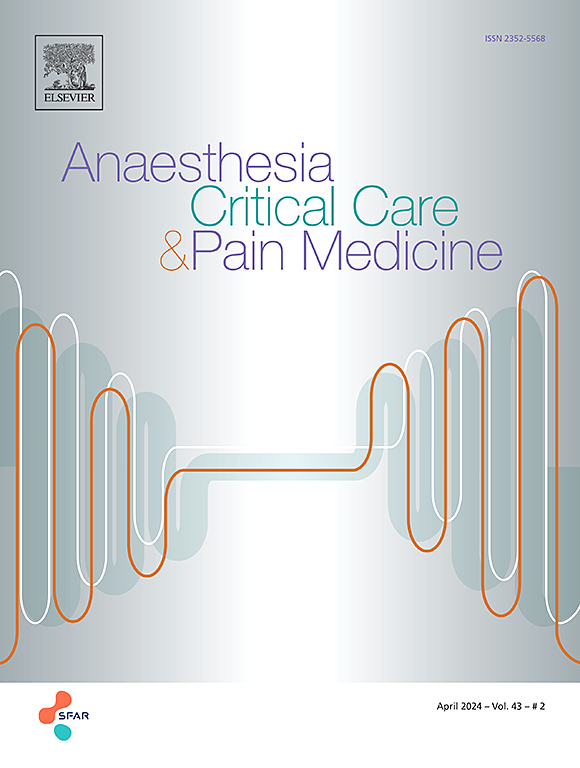Structural, material and functional organisation of centres performing paediatric anaesthesia
IF 3.7
3区 医学
Q1 ANESTHESIOLOGY
引用次数: 0
Abstract
Objective
The French Society of Anesthesiology and Critical Care (Société Française d'Anesthésie et de Réanimation (SFAR)) and the French association of paediatric intensive care anaesthetists (Association des Anesthésistes Réanimateurs Pédiatriques d'Expression Française (ADARPEF)) have joined forces to provide guidelines for professional practice on the structural, material, and functional organisation of centres performing pediatric anesthesia.
Design
A consensus committee of 16 experts from the SFAR and the ADARPEF was convened. The experts declared no conflict of interest before and throughout the process. The entire guidelines process was conducted independently of any industry funding. The authors were asked to follow the principles of the Grading of Recommendations Assessment, Development and Evaluation (GRADE) system to guide the assessment of the quality of evidence.
Methods
Four fields were defined: (1) structure and logistics; (2) equipment and materials; (3) training; and (4) functional organisation. For each field, the objective of the recommendations was to answer a number of questions formulated according to the PICO model (population, intervention, comparison, and outcomes). Based on these questions, an extensive bibliographic search was carried out on works published from 2000 to 2022, using predefined keywords according to PRISMA guidelines and analyzed using the GRADE® methodology. Because of the very small number of studies that could provide the necessary power for the most important endpoint (i.e., morbidity), it was decided, before drafting the recommendations, to adopt a Recommendations for Professional Practice (RPP) format rather than a Formalised Recommendations of Experts (RFE) format. The recommendations were formulated according to the GRADE® methodology, before being voted on by all the experts according to the GRADE grid method.
Results
The experts' synthesis work and the application of the GRADE® method resulted in 34 recommendations dealing with the structural, material and functional organization of centers performing pediatric anaesthesia. After three rounds of rating and several amendments, an agreement was reached on all the recommendations.
Conclusions
Strong agreement exists among the experts to provide recommendations aimed at improving the structural, material and functional organization of centers performing paediatric anaesthesia.
执行儿科麻醉中心的结构、材料和功能组织$,$。
目的:麻醉学的法国社会和急救护理(法国法语d 'Anesthesie et de复活(SFAR))和法国儿科重症监护麻醉师协会(协会des Anesthesistes Reanimateurs Pediatriques d 'Expression法语(ADARPEF))联手为专业实践提供指导结构,材料,功能组织中心执行小儿麻醉。设计:由来自SFAR和ADARPEF的16名专家组成的共识委员会召开。专家们宣布在整个过程之前和整个过程中都没有利益冲突。整个指导方针过程是独立于任何行业资助进行的。要求作者遵循建议分级、评估、发展和评价(GRADE)系统的原则来指导证据质量的评估。方法:定义4个领域:1)结构与物流;2)设备和材料;3)培训;4)职能组织。对于每个领域,建议的目标是回答根据PICO模型(人口、干预、比较和结果)制定的一些问题。基于这些问题,对2000年至2022年出版的作品进行了广泛的书目检索,根据PRISMA指南使用预定义的关键词,并使用GRADE®方法进行了分析。由于能够为最重要的终点(即发病率)提供必要力量的研究数量非常少,因此在起草建议之前,决定采用专业实践建议(RPP)格式,而不是正式的专家建议(RFE)格式。这些建议是根据GRADE®方法制定的,然后由所有专家根据GRADE网格方法投票。结果:专家的综合工作和GRADE®方法的应用产生了34条建议,涉及实施儿科麻醉的中心的结构、材料和功能组织。经过三轮评比和几次修正,各方就所有建议达成一致。结论:专家之间存在强烈的共识,以提供建议,旨在改善中心的结构,材料和功能组织执行儿科麻醉。
本文章由计算机程序翻译,如有差异,请以英文原文为准。
求助全文
约1分钟内获得全文
求助全文
来源期刊

Anaesthesia Critical Care & Pain Medicine
ANESTHESIOLOGY-
CiteScore
6.70
自引率
5.50%
发文量
150
审稿时长
18 days
期刊介绍:
Anaesthesia, Critical Care & Pain Medicine (formerly Annales Françaises d''Anesthésie et de Réanimation) publishes in English the highest quality original material, both scientific and clinical, on all aspects of anaesthesia, critical care & pain medicine.
 求助内容:
求助内容: 应助结果提醒方式:
应助结果提醒方式:


